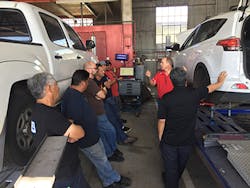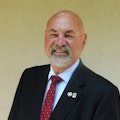How should you measure the real cost of running your business?

The industry must start to acknowledge that the “trade days” are over and we are now in a true profession. Use “profession” in your vocabulary when speaking and writing, and get rid of the word “trade.” The service shop is truly a knowledge-based business. Thanks to computer technology on vehicles today, diagnostics capability is a key part in truly servicing the client. A new era has been born.
As a profession, measurements have changed compared to the trade days. Sales and car count were important in the trade days, as it measured activity. But in this new era of knowledge base, the new focus must be on productivity. Recognize this fact and start to move your business to the next level over the next two years.
We have learned that 60 to 65 percent of the business coming through a service shop today does not create a single dollar of net profit, although it creates a sale and gross profit. People out there still believe when sales are up, they are doing better. But that is not the case anymore. Although it may not be possible to create net profit on every job, if your percentage of unprofitable jobs fell from 60 to 65 percent to 35 to 40 percent, your net profit would soar. The question, then, is, “What should I now be measuring in my business?”
If you slow down and take the time to do a few calculations, you will have a powerful “tool” at your fingertips.
Many shop operators measure their cost of doing business by taking their total annual expenses from their financial statement and dividing that number by 365 to provide a cost-per-day figure. Others take the same expense number and divide it by the number of days in the year they are actually open to provide them with their cost per operating day, which is a more accurate measurement. That is a reasonable starting point if you have never had any measurements before, but consider the challenges of running an automotive maintenance shop in today’s reality. It does not really matter how many days or hours you are open; it matters how many hours you bill.
Consider the following exercise: total your revenue from last year in each labor category (maintenance, diagnostic, reflash, etc.), In each category, divide each category’s labor total by the appropriate labor rate of that category. This gives you the total number of labor hours billed for the year in each category. Add the hours up for one total amount of hours billed.
Take your total expenses for the year from your accountant’s financial statement.
To that total, add the non-commodity purchases, such as any expenses including technician wages, freight etc. the accountant placed in cost of goods sold. This now gives you the operation’s total operating expenses for the year.
Divide the total expenses by the total labor hours billed for the year. This now gives you your average cost of running your business per billed labor hour last year. Take your total net profit last year and divide it by the total billed hours to see what you made in net profit per billed hour last year.
Once you know these numbers, you can measure each job very quickly and quite accurately. First, calculate the total gross profit made (include total labor revenue) on the RO. Next take the actual hours billed on that RO and multiply the hours by your average cost per billed labor hour you calculated above. Take the total gross profit dollars and subtract the total cost, which now gives you a reasonably accurate account of the net profit you will make on that service work. Compare that to your average net profit per billed hour last year. Are you higher or lower than last year’s average? Remember, you are in business to create net profit, not just create activity.
I recommend you fine-tune this each month using your year-to-date numbers divided by the number of months to calculate your actual average labor hours billed per month. When comparing your numbers to the same month of the previous year, don’t look at sales; look at the labor hours billed. If your hours billed goes up this year, then you were actually more productive, and over time, it will lower your cost per billed hour. You cannot say the same if you only measured sales. Sales measurement is a measurement of activity. Increased productivity, however, dramatically leads to increased bottom-line profitability.
Calculate the gross profit per billed hour for the current month and compare that figure to that of the same month in the previous year. Are you up or down this year? From your monthly financial statement, use the year-to-date numbers to calculate and compare your costs per billed hour this year to last year. Are you up or down? Finally, your gross profit per billed hour, less the cost per billed hour, equals your net profit per billed hour. Are you up or down?
From an attitude perspective, it is important you know you are making progress each day toward your annual net profit goal. This quick measurement will help keep you focused to achieve that goal. Keep it simple, but know your facts, because math does not lie.
About the Author

Bob Greenwood
Robert (Bob) Greenwood, AMAM (Accredited Master Automotive Manager) was the President and C.E.O. of Automotive Aftermarket E-Learning Centre Ltd. (AAEC). AAEC is a company focused on providing Business Management Resources and Development for the Independent Sector of the aftermarket industry utilizing the Internet environment. AAEC content and technology is recognized as part of the curriculum of the Fixed Operations Diploma and the Aftermarket Degree courses taken at the Automotive Business School of Canada in Georgian College located in Barrie, Ontario, Canada. This school is the leader and only college in Canada that offers an automotive business education. AAEC is also recognized by the Automotive Management Institute (AMI), located in Colleyville, Texas USA, allowing 80 credits for successful completion of the AAEC E-Learning portion of the site towards the 120 credits required to obtain the reputable Accredited Automotive Manager (AAM) designation. The Automotive Management Institute’s Accredited Automotive Manager designation is the first business management accreditation exclusively for the automotive service professional. To date, AMI various programs have attracted more than 212,000 enrolments throughout North America.
Greenwood died on Sept. 9 in Surrey, British Columbia, Canada, from a heart attack. He was a regular contributor to Motor Age magazine and will be greatly missed. See some of his recent work here:
Where is your shop today: Do you have a career or job culture?
Part one of a three-part series looks at a sample policy manual for your team
How should you measure the real cost of running your business?
A few quick calculations can provide powerful insights into business productivity and profitability.
Shop of the future is becoming reality
Thousands of independent shops will disappear over the next few years, but those that survive will be great businesses. Let's look at what these shops will have done to remain successful.
See more of his articles below.